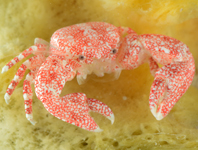Abstract
Aegiochus gracilipes Hansen, 1895 was described from a single immature specimen accompanied by three figures (Hansen 1895). Hansen (1916) subsequently reported the species without figures. Over the next 100 years A. gracilipes only appeared in the literature as a citation in larger review and cataloguing studies. Most significantly, Bruce (2009) transferred A. gracilipes from Aega Leach, 1815 to Aegiochus Bovallius, 1885, as part of a broader study redefining the morphological characters used to distinguish Aegiochus. To the present day A. gracilipes, described from the north-eastern Atlantic off the Outer Hebrides, Scotland, is known only from the original figures and its limited primary description.
References
Bovallius, C. (1885) A new isopod from the Swedish Arctic Expedition of 1883. Bihang til Kongeliga Svenska Vetenskapsakademiens Handlingar, 10, 1–12, pls. 11 + 12.
Bruce, N.L. (2009) The marine fauna of New Zealand, Isopoda, Aegidae (Crustacea). NIWA Biodiversity Memoir, 122, 1–252.
Brusca, R.C. (1983) A monograph on the isopod family Aegidae in the tropical eastern Pacific. The genus Aega. Allan Hancock Monographs in Marine Biology, 12, 1–39.
Gurjanova, E.F. (1932) The Isopods of Arctic Seas. In: Analytical Tables of the Fauna of the USSR. Vol. 4. Academii Nauk, Leningrad, pp. 1–35.
Hansen, H.J. (1895) Isopoden, Cumaceen und Stomatopoden der Plankton-Expedition. Ergebnisse der Plankton-Expedition der Humboldt-Stiftung, 2, 1–105.
https://doi.org/10.5962/bhl.title.10413
Hansen, H.J. (1916) The order Isopoda. In: Crustacea Malacostraca. Danish Ingolf Expedition. Vol. 3. Zoologisk Museum, Copenhagen, pp. 1–262.
Kensley, B. & Schotte M. (1989) Guide to the Marine Isopod Crustaceans of the Caribbean. Smithsonian Institution Press, Washington, D.C. & London, 308 pp.
https://doi.org/10.5962/bhl.title.10375
Leach, W.E. (1814) Crustaceology. In: Brewster, D. (Ed.), The Edinburgh Encyclopaedia. Vol. 7. Baldwin, London, pp. 383–437, pl. 221.
Leach, W.E. (1815) A tabular view of the external characters of four classes of animals which Linné arranged under Insecta with the distribution of the genera composing three of these classes into Orders, and description of several new genera and species. Transactions of the Linnean Society of London, 11, 306–400.
https://doi.org/10.1111/j.1096-3642.1813.tb00065.x
Menzies, R.J. & Kruczynski W.L. (1983) Isopod Crustacea (exclusive of Epicaridea). Memoirs of the Hourglass Cruises, 6, 1–126.
Nierstrasz, H.F. (1931) Isopoda genuina. II. Flabellifera. In: Weber, M. & De Beaufort, L.F. (Eds.), Die Isopoden der Siboga-Expedition. Vol. 19. 32c. E.J. Brill, Leiden, pp. 123–233, pls. 110–111.
Richardson, H. (1901) Key to the Isopoda of the Atlantic coast of North America with descriptions of new and little known species. Proceedings of the United States National Museum, 23, 493–579.
https://doi.org/10.5479/si.00963801.23-1222.493
Richardson, H. (1905) A monograph on the isopods of North America. Bulletin of the United States National Museum, 54, vii–liii + 1–727.
https://doi.org/10.5479/si.03629236.54.i
Schultz, G.A. (1969) How to know the marine isopod crustaceans. Vol. 140. Wm. C. Brown,Dubuque, Iowa 14 pp. [pp. 114–127]
Wägele, J.-W. (1989) Evolution und phylogenetisches System der Isopoda. Stand der Forschung und neue Erkenntnisse. Zoologica, 140, 1–262.
Watling, L. (1989) A classification concept for crustacean setae based on the homology concept. In: Felgenhauer, B.E., Watling, L. & Thistle, A.B. (Eds.), Functional morphology of feeding and grooming in Crustacea. Vol. 6. A.A. Balkema, Rotterdam, pp. 15–26.
White, A. (1850) Part IV.—Crustacea. In: List of the specimens of British animals in the collection of the British Museum. British Museum, London, pp. i–iv + 1–141.


